back to
Farley's Follies – The Farley Special Printings of 1935
No United States stamps of the 20th century are involved in more scandal and controversy than the 20 stamps known as "Farley's Follies", the "Farley Special Printings" or the "Farley Reprints". Here's the story of how these came about, how these innocent gifts to family and friends caused an uproar in the philatelic community, and how it took a Presidential order to give every collector the opportunity to own what were once special varieties not available to the public.
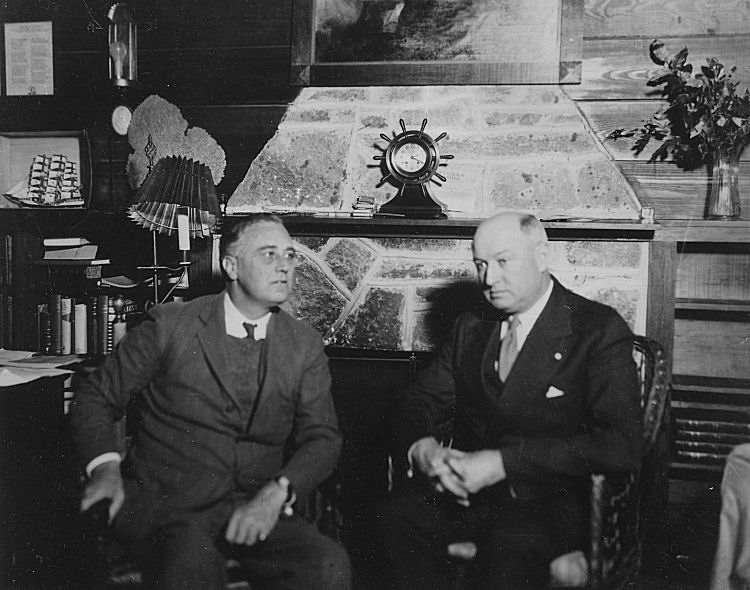 |
| FDR and James Farley in Warm Springs, 1931 |
Who was James Farley?
James A. Farley (1888-1976) was a prominent businessman and manager of Alfred E. Smith's successful 1922 campaign for Governor of New York when Franklin D. Roosevelt asked him to run his 1928 campaign for Governor of New York. Pleased with his skills as campaign manager, Roosevelt again asked Farley to run his reelection campaign in 1930. So it was natural that when Roosevelt decided to run for President in 1932, Farley would once again run his campaign.
Following his victory in the 1932 Presidential election, Roosevelt, following political tradition, announced that Farley would become the new Postmaster General upon his inauguration on March 4, 1933. In an unusual step, Roosevelt also named Farley head of the Democratic National Committee in addition to his cabinet post.
Farley as Postmaster General
In early 1933, the nation was in the midst of the Great Depression and the Post Office was rapidly losing income. Under Farley's leadership, the Post Office began to turn a profit. He was instrumental in revolutionizing transcontinental airmail service, and worked with airlines to see that mail was delivered safely and efficiently.
However, stamp collectors remember Farley for something else: the creation of a number of stamps produced mainly for collectors. The President was an avid stamp collector, and he clearly influenced Farley to authorize the printing of special sheets of stamps to be sold to collectors at national stamp shows. In 1933 and 1934 five such sheets were issued.
The Beginnings of a Scandal
Although not a stamp collector himself, Farley would often visit the Bureau of Engraving and Printing to witness the first press run of a new issue. Knowing that the President and several other influential people in Roosevelt's administration were stamp collectors, Farley would often take the first few sheets off the press – before they were gummed and perforated – and sign and inscribe them to various friends and family members including President Roosevelt and Secretary of the Interior Harold Ickes, also a stamp collector. At the time he thought nothing of this, that since they were unfinished products they had no postal value and he paid for the stamps, and he enjoyed the publicity of witnessing the printing of every new stamp in front of press photographers. But when newspapers published photos of Farley autographing imperforate sheets of stamps, stamp dealers and collectors began writing the Post Office asking if these stamps were being issued in imperforate form, and if they were, could they be purchased. The response from Farley's secretary was that the stamps would be issued only in perforated form, and that the imperforate sheets were not released to the public.
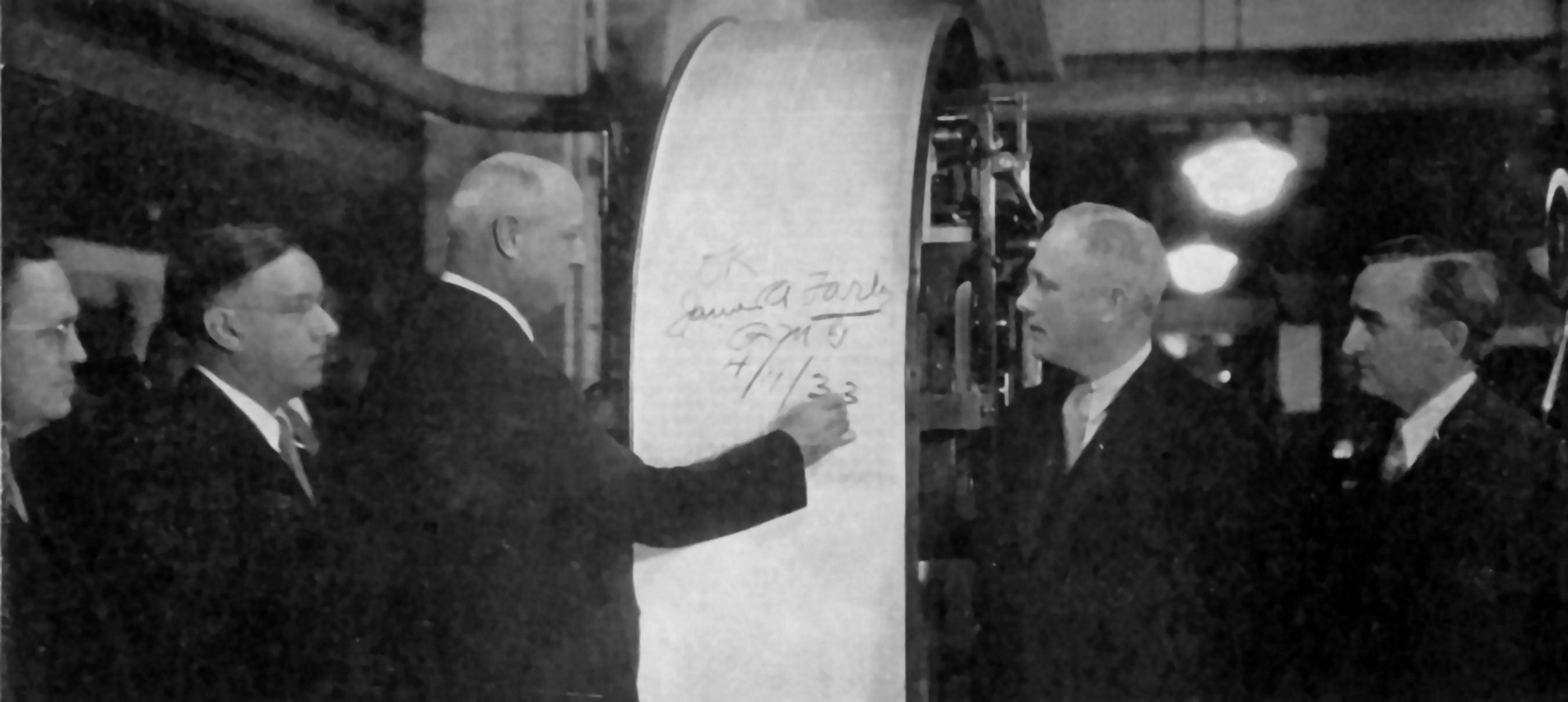 |
| Press photos such as this from April 1933 prompted collectors to ask if these imperforate sheets would be available for sale. |
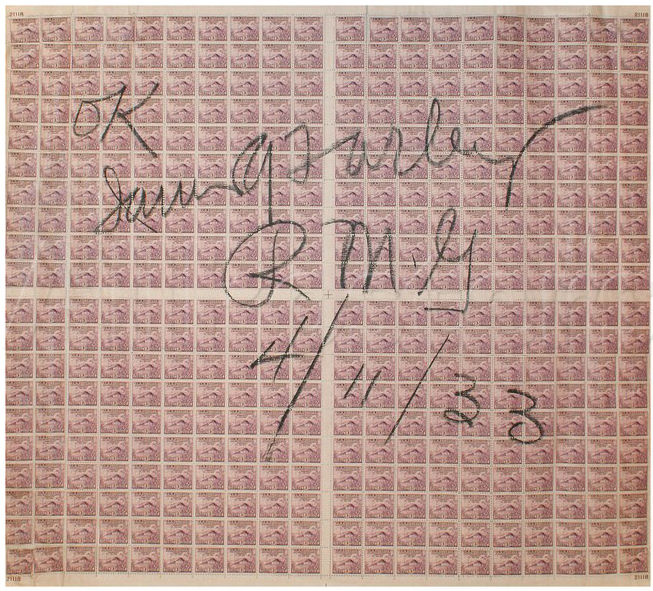 |
| A typical sheet signed by Farley as it came off the press. |
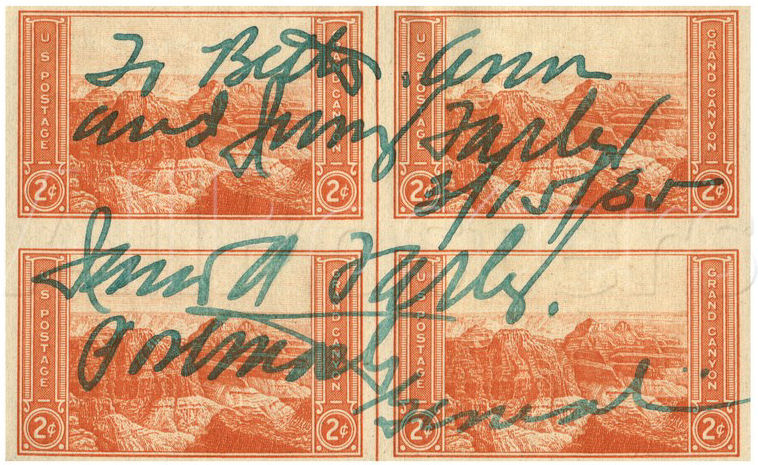 |
| Farley signed this block for his children. He often signed his name in green ink. |
Farley continued to give these special "first sheets off the press" to politicians, friends and family throughout 1933 and 1934, with occasional negative feedback from the philatelic community urging the Postmaster General to discontinue this practice, but little was done. But in November 1934 a full imperforate sheet of 200 of the Mother's Day issue, signed by Farley and given to a "friend of a friend" in Norfolk, Virginia, came on the philatelic market with an asking price of $30,000. The philatelic community was outraged, insisting that the Post Office shouldn't be in the business of creating rarities and demanded that the Post Office make these special printings available to all collectors. Suddenly, rumors of these "gift" stamps were true, and it was discovered that Farley had given away sheets of 17 such issues in 1933 and 1934, and some were starting to appear on the market for astronomical prices.
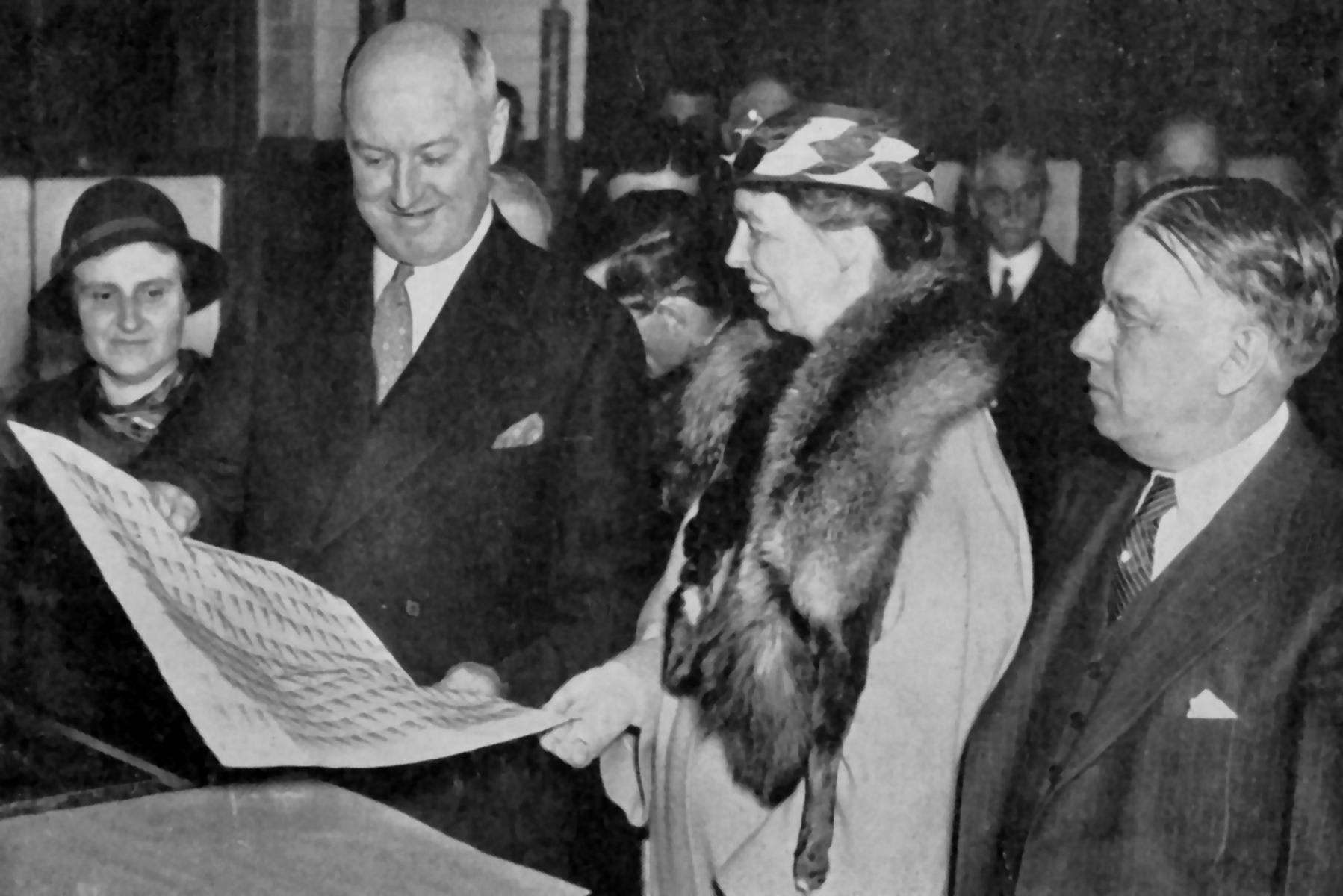 |
| Farley examines the first Mother's Day sheet off the press on April 13, 1934, with Eleanor Roosevelt and Third Assistant Postmaster General Clinton Eilenberger. |
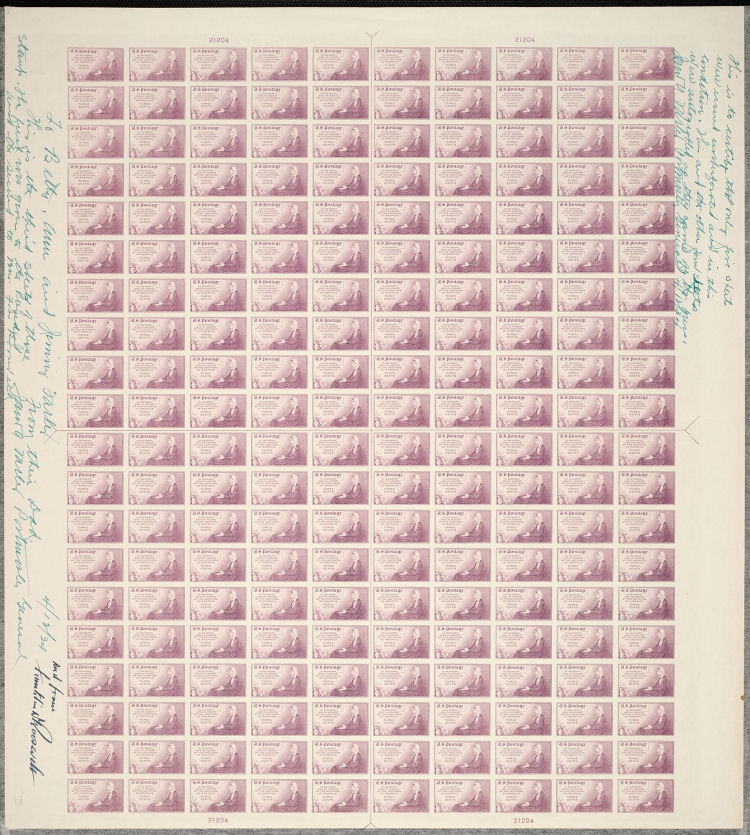 |
| The Mother's Day sheet, seen in the previous photo, signed to his children by Farley and President Roosevelt, and later donated to the Smithsonian. |
Hundreds of stamp collectors and stamp clubs wrote President Roosevelt, explaining the problem of these special printings and the problems they would create in the philatelic marketplace, and demanded that he do something about it. Word of this growing scandal reached Congress, and in late January 1935 Representative Charles Millard proposed investigating Farley over these inappropriate gifts, which he estimated had a market value of half a million dollars. Finally, in early February 1935, to avoid inquiry and to soothe his critics, Farley announced that additional printings would be made of all of the gift stamps, imperforate and ungummed as were the original gift sheets, and would be sold to collectors at face value. Beginning March 15, collectors would be able to order full sheets and blocks of four at face value from the Philatelic Agency in Washington for a period of three months until June 15, 1935. The full list was 20 issues, including the complete set of National Parks and special versions of the sheets issued at philatelic exhibitions.
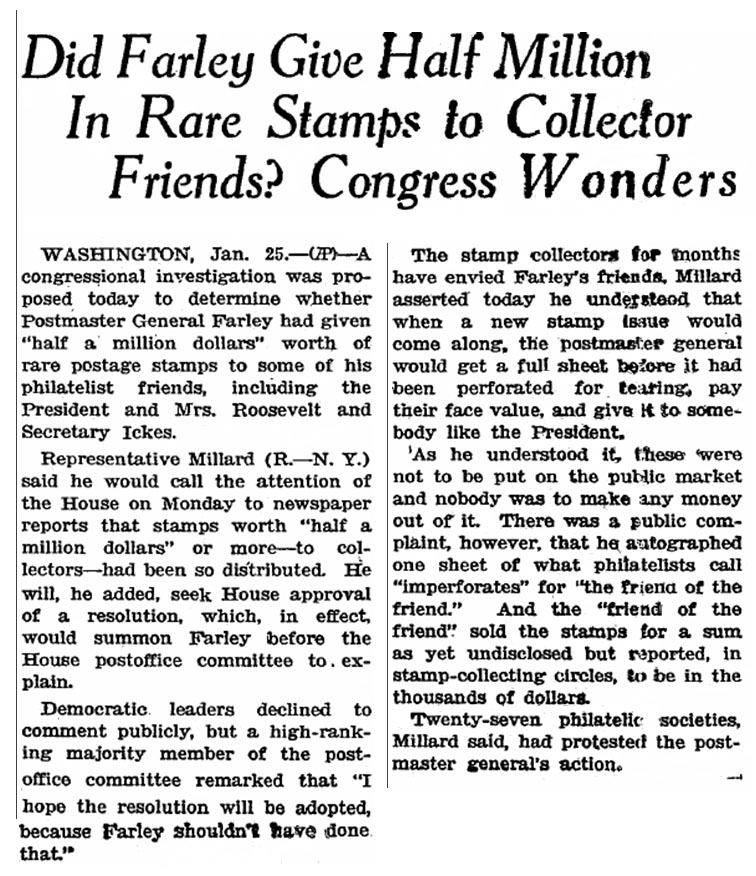 |
| A newspaper clipping from January 26, 1935, the day after Millard proposed investigating Farley. |
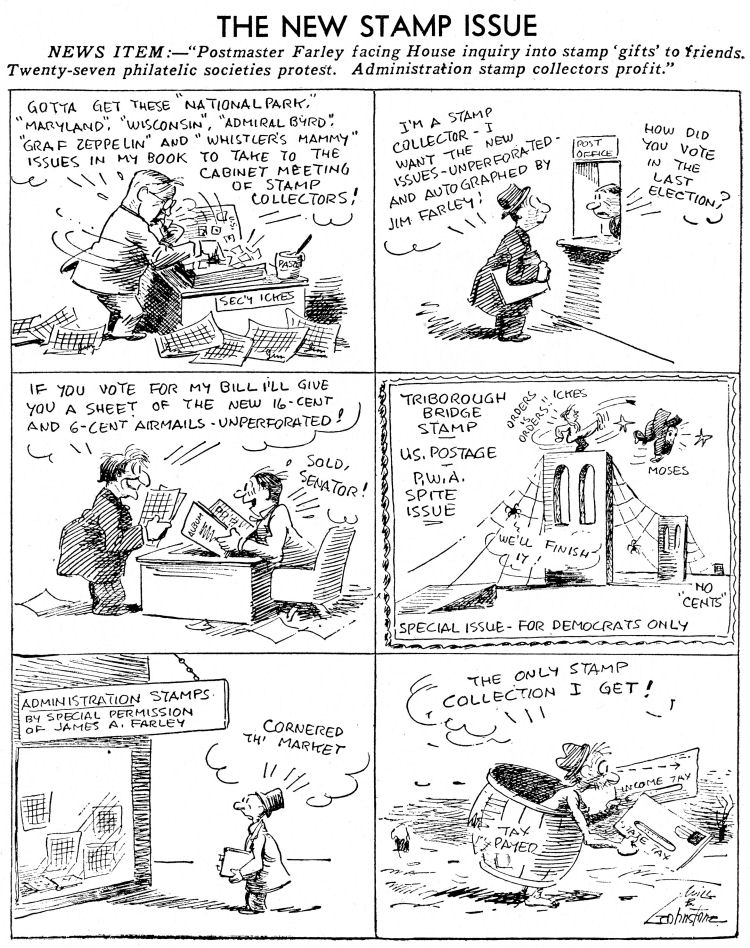 |
| "Farley's Follies" did not escape the scrutiny of political cartoonists, as evidenced by this cartoon from early 1935. |
With no "first day of issue" ceremony, these "Farley Special Printings" went on sale at the Philatelic Agency as planned on March 15, 1935. Collectors were able to buy full press sheets of 200 to 400 stamps with no limit. These special printings and the scandal surrounding their issue became known as "Farley's Follies" and occupy a unique position in the history of the United States Post Office and its stamps. Farley took this lesson to heart and became a strong advocate for philatelists, and in his remaining years as Postmaster General he regained the respect among collectors that he lost during the scandal, greenlighting popular issues such as the Presidental series, the Army-Navy issue, and the Famous Americans series.
Farley later donated the original sheets he signed for family members to the Smithsonian Institution, and today they may be seen in the National Postal Museum.
In 1940 the Post Office offered to add gum to the Special Printing sheets free of charge if collectors sent them in. However, few collectors took advantage of this offer and the majority of the "Farley's Follies" in collectors hands today are in the original ungummed form.
What Happened to Farley?
James Farley resigned as Postmaster General in 1940, disagreeing with President Roosevelt's decision to run for a third term as President. After leaving office, he was named Chairman of the Board of the Coca Cola Corporation, a post he held until his retirement in 1973. He died in New York City in 1976, and was the last surviving member of Roosevelt's cabinet.
Identifying the Farley Special Printings
3¢ Washington's Headquarters (US #752) – sold only in perforated form without gum
3¢ Byrd Expedition (US #753) – sold only in perforated form without gum
3¢ Whistler's Mother (US #754) – imperforate without gum
3¢ Wisconsin Tercentenary (US #755) – imperforate without gum
National Parks set of 10 (US #756-65) – imperforate without gum
1¢ Fort Dearborn sheet of 25 (US #766, single #766a) – imperforate without gum
3¢ Federal Building sheet of 25 (US #767, single #767a) – imperforate without gum
3¢ Byrd Expedition sheet of 6 (US #768, single #768a) – imperforate without gum
1¢ Yosemite sheet of 6 (US #769, single #769a) – imperforate without gum
3¢ Mt. Rainier sheet of 6 (US #770, single #770a) – imperforate without gum
16¢ Great Seal (US #771) – imperforate without gum
To identify the sheets (#766-770), the Special Printings are ungummed, and were sold as large press sheets. Individual sheets were cut from the press sheets by hand, and the margins are typically larger and uneven compared to the uniform and straight margins of the original printings. The original Mt. Rainier and Yellowstone sheets of 6 (#750 and 751) were gummed.
Because full press sheets were sold to collectors, it is popular to collect the Special Printings in formats not available on the previously gummed and perforated counterparts. Stamps cut from the press sheets can be found in many varieties, including gutter pairs, cross gutter blocks, guide line pairs, and cross guide line blocks. And despite their relative scarcity – for example, only 5,734 sheets of the imperforate Air Mail Special Delivery stamp were printed – the "Farleys" are still within the budget of most collectors.

